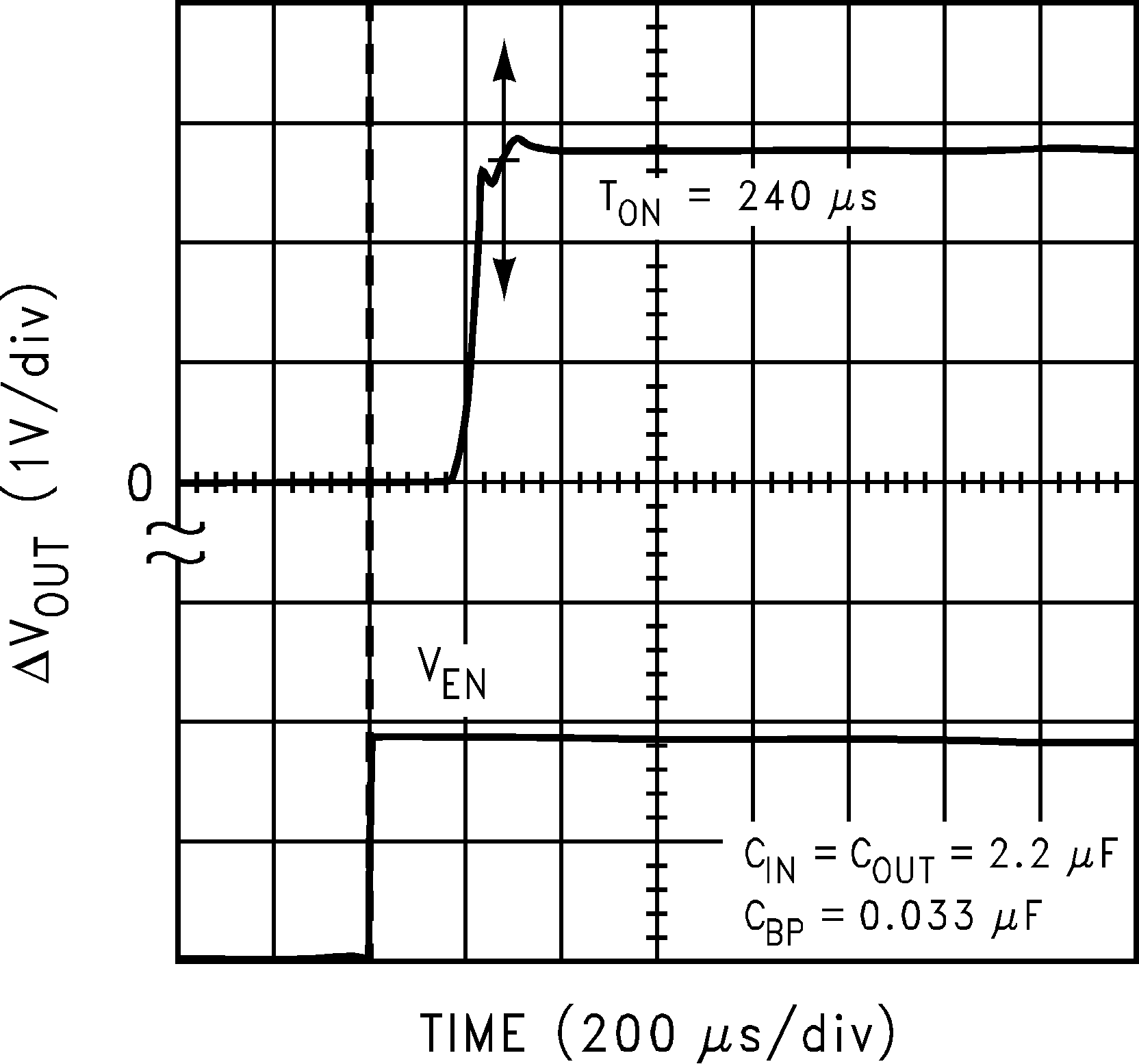SNVS159H October 2001 – July 2015 LP3981
PRODUCTION DATA.
- 1 Features
- 2 Applications
- 3 Description
- 4 Revision History
- 5 Pin Configuration and Functions
- 6 Specifications
- 7 Parameter Measurement Information
- 8 Detailed Description
- 9 Application and Implementation
- 10Power Supply Recommendations
- 11Layout
- 12Device and Documentation Support
- 13Mechanical, Packaging, and Orderable Information
Package Options
Mechanical Data (Package|Pins)
Thermal pad, mechanical data (Package|Pins)
Orderable Information
6 Specifications
6.1 Absolute Maximum Ratings
over operating free-air temperature range (unless otherwise noted)(1)(2)(3)| MIN | MAX | UNIT | |||
|---|---|---|---|---|---|
| IN, EN | −0.3 | 6.5 | V | ||
| OUT, OUT-SENSE | −0.3 to VIN + 0.3 | 6.5 | V | ||
| Junction temperature | 150 | °C | |||
| Storage temperature, Tstg | −65 | 150 | °C | ||
(1) Stresses beyond those listed under Absolute Maximum Ratings may cause permanent damage to the device. These are stress ratings only, which do not imply functional operation of the device at these or any other conditions beyond those indicated under Recommended Operating Conditions. Exposure to absolute-maximum-rated conditions for extended periods may affect device reliability.
(2) All voltages are with respect to the potential at the GND pin.
(3) If Military/Aerospace specified devices are required, contact the TI Sales Office/Distributors for availability and specifications.
6.2 ESD Ratings
| VALUE | UNIT | |||
|---|---|---|---|---|
| V(ESD) | Electrostatic discharge | Human-body model (HBM), per ANSI/ESDA/JEDEC JS-001(1) | ±2000 | V |
| Machine model | ±200 | |||
(1) JEDEC document JEP155 states that 500-V HBM allows safe manufacturing with a standard ESD control process.
6.3 Recommended Operating Conditions
over operating free-air temperature range (unless otherwise noted)(1)(2)| MIN | NOM | MAX | UNIT | |||
|---|---|---|---|---|---|---|
| VIN | 2.7 | 6 | V | |||
| VEN | 0 | VIN | V | |||
| Junction temperature | –40 | 125 | °C | |||
(1) Stresses beyond those listed under Absolute Maximum Ratings may cause permanent damage to the device. These are stress ratings only, which do not imply functional operation of the device at these or any other conditions beyond those indicated under Recommended Operating Conditions. Exposure to absolute-maximum-rated conditions for extended periods may affect device reliability.
6.4 Thermal Information
| THERMAL METRIC(1) | LP3981 | UNIT | ||
|---|---|---|---|---|
| DGK (VSSOP) | NGC (WSON) | |||
| 8 PINS | 6 PINS | |||
| RθJA | Junction-to-ambient thermal resistance, High K | 177 | 56.5 | °C/W |
| RθJC(top) | Junction-to-case (top) thermal resistance | 67.7 | 76.8 | °C/W |
| RθJB | Junction-to-board thermal resistance | 97.4 | 30.9 | °C/W |
| ψJT | Junction-to-top characterization parameter | 10.8 | 3.3 | °C/W |
| ψJB | Junction-to-board characterization parameter | 96 | 31 | °C/W |
| RθJC(bot) | Junction-to-case (bottom) thermal resistance | N/A | 10.7 | °C/W |
(1) For more information about traditional and new thermal metrics, see the Semiconductor and IC Package Thermal Metrics application report, SPRA953.
6.5 Electrical Characteristics
Unless otherwise specified: VEN = 1.2 V, VIN = VOUT + 0.5 V, CIN = 2.2 µF, CBP = 0.033 µF, IOUT = 1 mA, COUT = 2.2 µF. All values are for TJ = 25°C, unless otherwise specified.(1)(2)| PARAMETER | TEST CONDITIONS | MIN | TYP | MAX | UNIT | |
|---|---|---|---|---|---|---|
| ΔVOUT | Output voltage tolerance | −2 | 2 | % of VOUT(nom) |
||
| TJ = –40°C to +125°C | –3 | 3 | ||||
| Line regulation error | VIN = VOUT + 0.5 V to 6 V, TA < 85°C | −0.1 | 0.005 | 0.1 | %/V | |
| VIN = VOUT + 0.5 V to 6 V, TJ ≤125°C | –0.2 | 0.2 | ||||
| Load regulation error(3) | IOUT = 1 mA to 300 mA | 0.0003 | %/mA | |||
| IOUT = 1 mA to 300 mA TJ = –40°C to +125°C |
0.005 | |||||
| PSRR | Power supply rejection ratio(4) | VIN = VOUT(nom) + 1 V, ƒ = 1 kHz, IOUT = 50 mA (Figure 16) |
50 | dB | ||
| VIN = VOUT(nom) + 1 V, ƒ = 10 kHz, IOUT = 50 mA (Figure 16) |
55 | |||||
| IQ | Quiescent current | VEN = 1.2 V, IOUT = 1 mA | 70 | µA | ||
| VEN = 1.2 V, IOUT = 1 mA TJ = –40°C to +125°C |
120 | |||||
| VEN = 1.2 V, IOUT = 1 mA to 300 mA, VOUT = 2.5 V(5) |
170 | |||||
| VEN = 1.2 V, IOUT = 1 mA to 300 mA, VOUT = 2.5 V TJ = –40°C to +125°C(5) |
210 | |||||
| VEN = 0.4 V | 0.003 | |||||
| VEN = 0.4 V, TJ = –40°C to +125°C | 1.5 | |||||
| Dropout voltage (6) | IOUT = 1 mA | 0.5 | mV | |||
| IOUT = 1 mA, TJ = –40°C to +125°C | 5 | |||||
| IOUT = 200 mA | 88 | |||||
| IOUT = 200 mA, TJ = –40°C to +125°C | 133 | |||||
| IOUT = 300 mA | 132 | |||||
| IOUT = 300 mA, TJ = –40°C to +125°C | 200 | |||||
| ISC | Short-circuit current limit | Output grounded (steady state) | 600 | mA | ||
| en | Output noise voltage | BW = 10 Hz to 100 kHz, CBP = 0.033 µF |
35 | µVRMS | ||
| TSD | Thermal shutdown temperature | 160 | °C | |||
| Thermal shutdown hysteresis | 20 | |||||
| IOUT(PK) | Peak output current | VOUT ≥ VOUT (nom) – 5% | 300 | 455 | mA | |
| IEN | Maximum input current at VEN | VEN = 0 and VIN | 0.001 | µA | ||
| VIL | Logic low input threshold | VIN = 2.7 V to 6 V, TJ = –40°C to +125°C | 0.4 | |||
| VIH | Logic high input threshold | VIN = 2.7 V to 6 V, TJ = –40°C to +125°C | 1.4 | |||
| OUTPUT CAPACITANCE | ||||||
| COUT | Output capacitor | Capacitance | 2.2 | 22 | µF | |
| ESR | 5 | 500 | mΩ | |||
(1) Minimum (MIN) and maximum (MAX) limits are ensured by design, test, or statistical analysis. Typical (TYP) numbers are not verified, but do represent the most likely norm.
(2) The target output voltage, which is labeled VOUT(nom), is the desired voltage option.
(3) An increase in the load current results in a slight decrease in the output voltage and vice versa.
(4) Specified by design. Not production tested.
(5) For VOUT > 2.5 V, increase IQ(MAX) by 2.5 µA for every 0.1 V increase in VOUT(nom); that is,
IQ(MAX) = 210 µA + ((VOUT(NOM) – 2.5) × 25) µA .
IQ(MAX) = 210 µA + ((VOUT(NOM) – 2.5) × 25) µA .
(6) Dropout voltage is the input-to-output voltage difference at which the output voltage is 100 mV below its nominal value. This specification does not apply for input voltages below 2.5 V.
6.6 Timing Requirements
| MIN | NOM | MAX | UNIT | ||
|---|---|---|---|---|---|
| tON | Turnon time (1)(2)
CBYPASS = 0.033 µF |
240 | µs | ||
| CBYPASS = 0.033 µF, TJ = –40°C to +125°C | 350 | ||||
(1) Specified by design. Not production tested.
(2) Turnon time is time measured between the enable input just exceeding VIH and the output voltage just reaching 95% of its nominal value.
6.7 Typical Characteristics
Unless otherwise specified, CIN = COUT = 2.2 µF ceramic, CBP = 0.033 µF, VIN = VOUT + 0.5 V, TA = 25°C, EN pin is tied to VIN.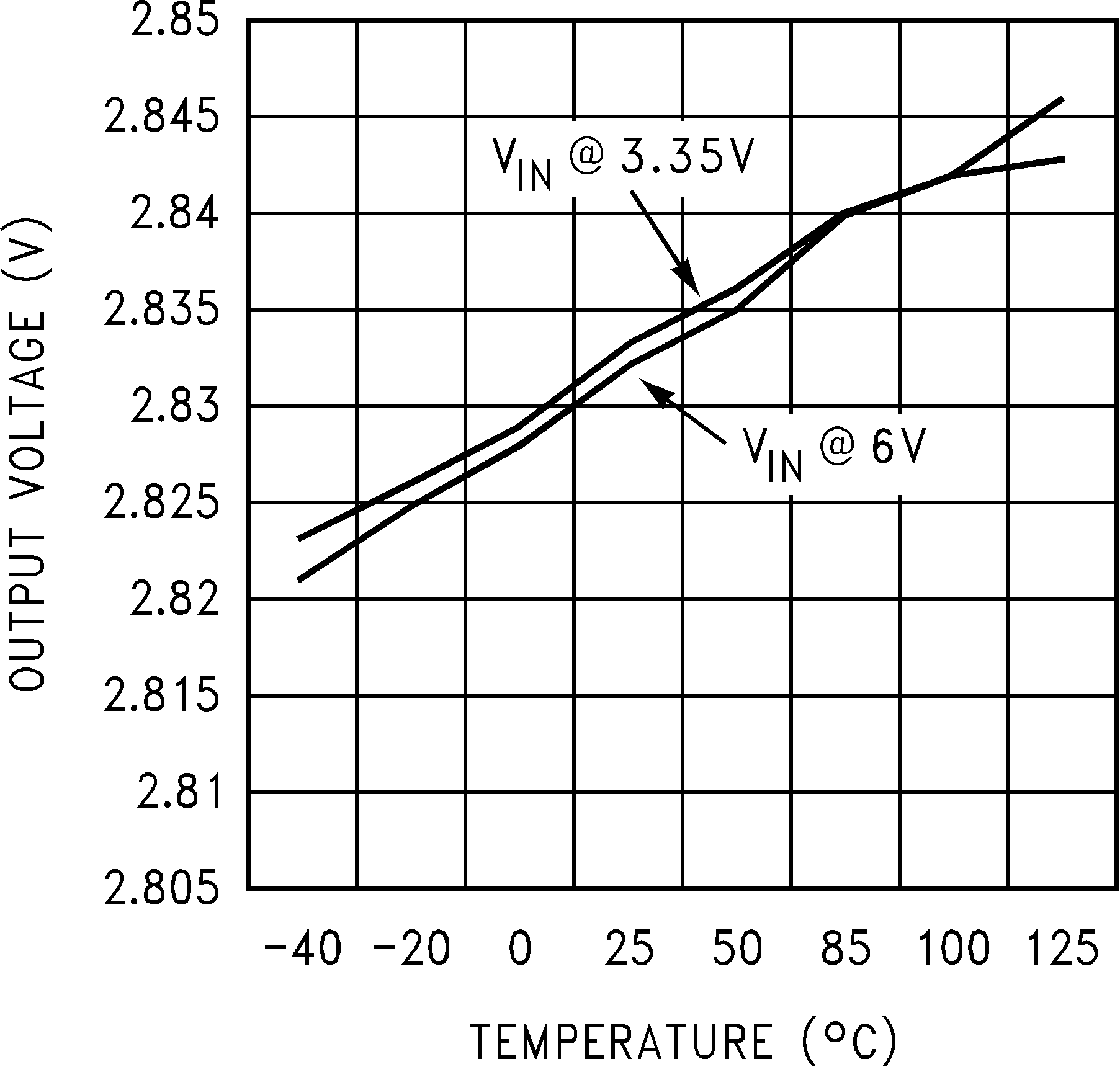
| VOUT = 2.83 V | ||
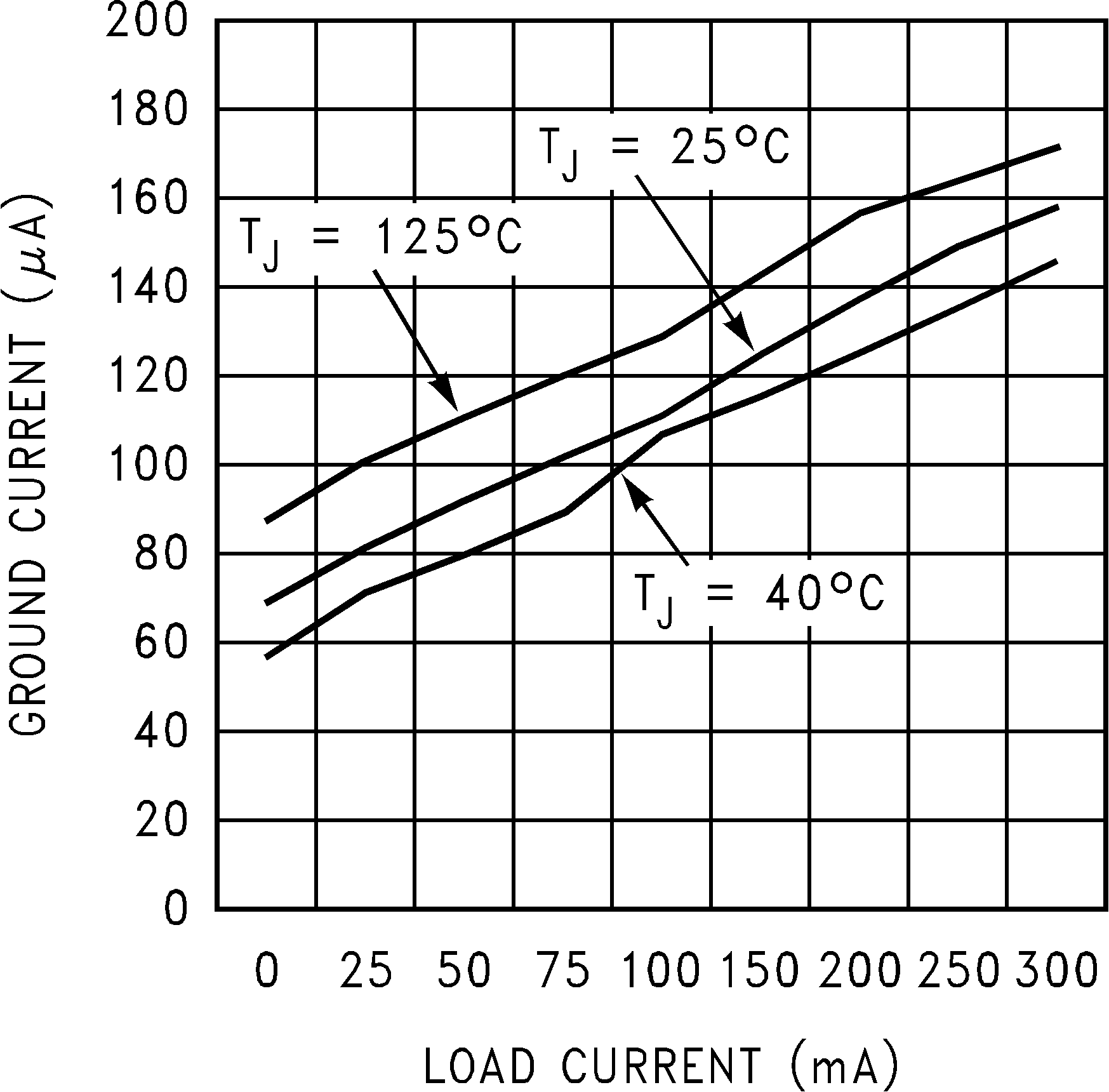
| VOUT = 2.85 V | ||
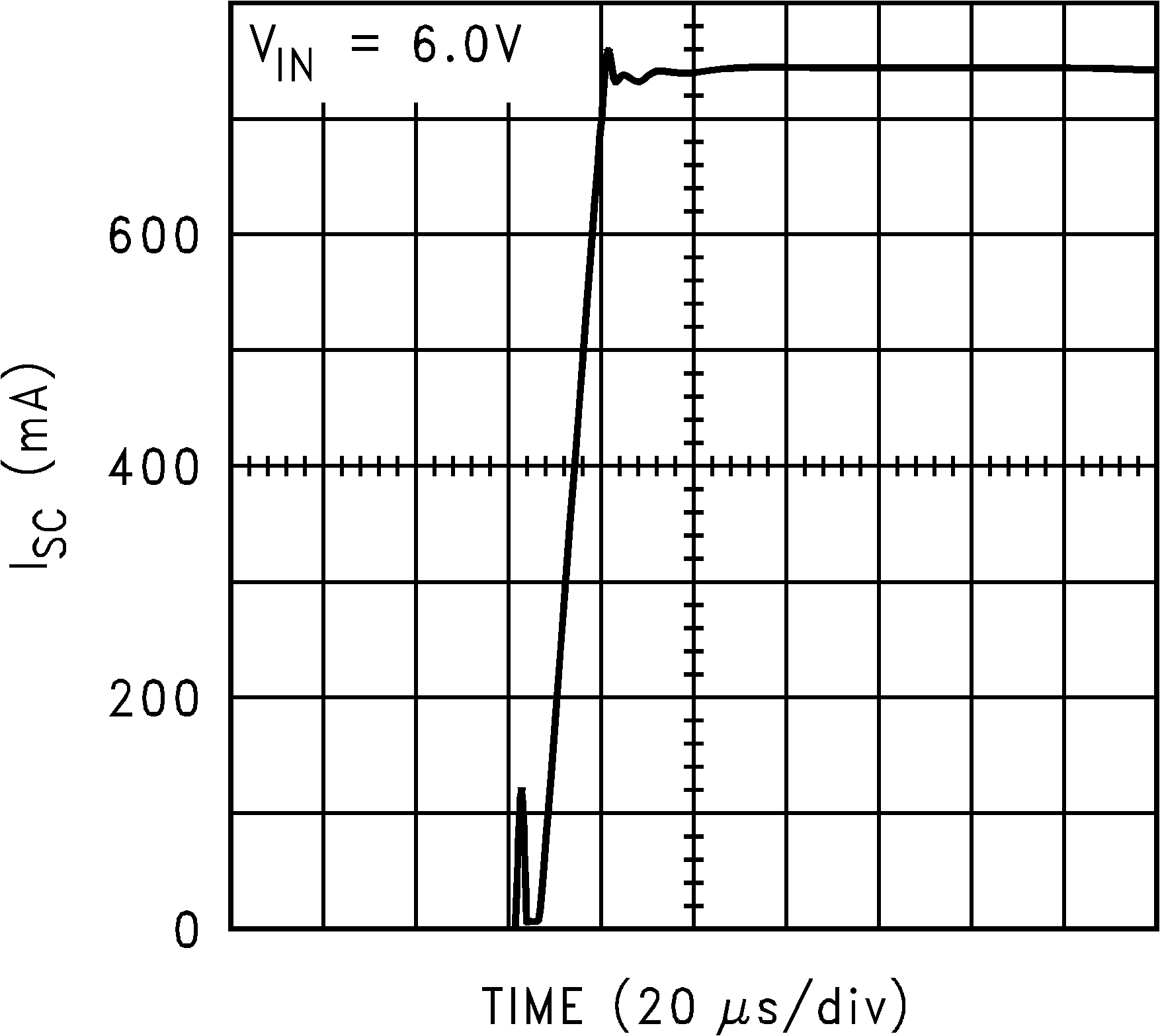
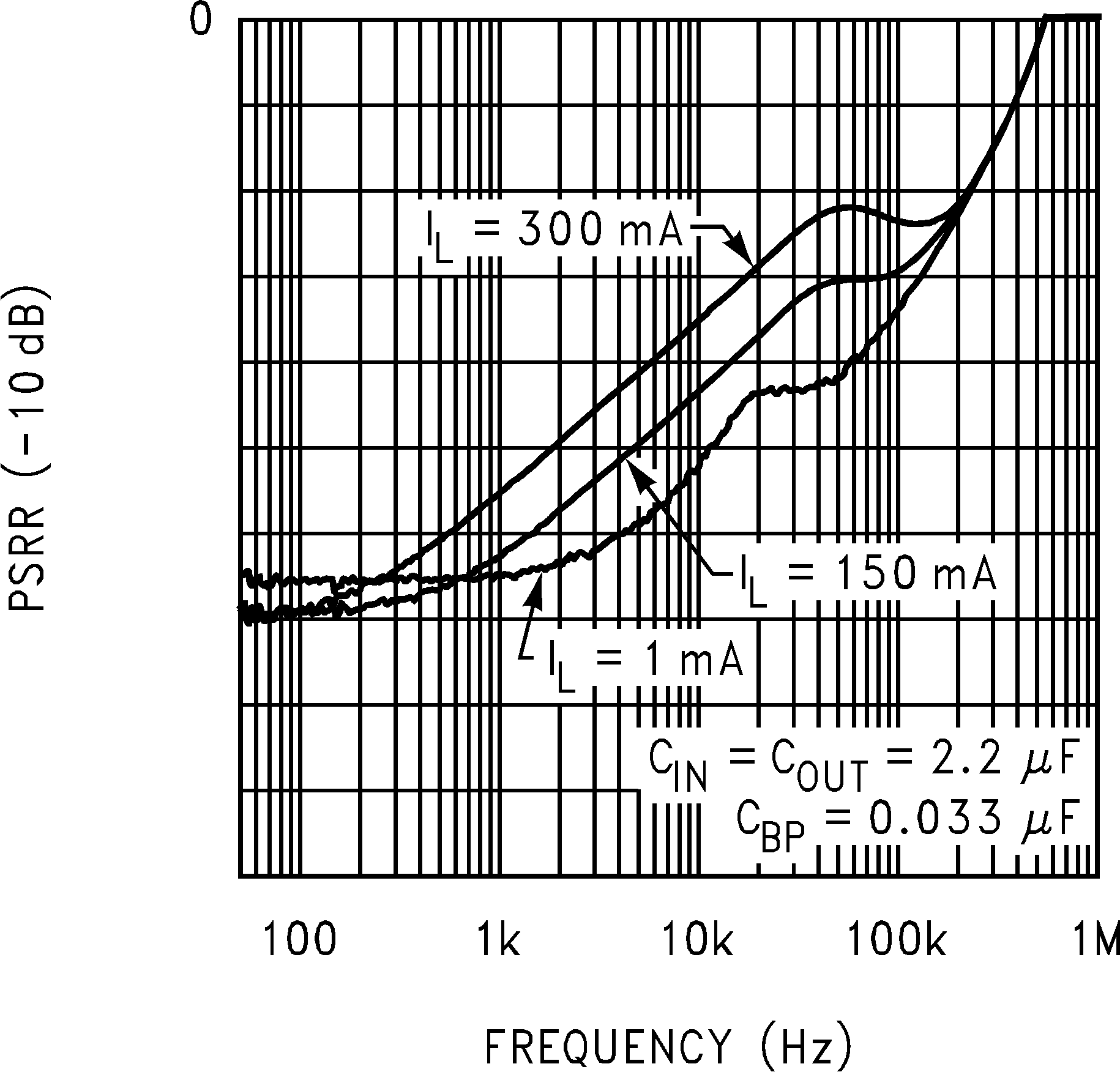
| VIN = VOUT + 1 V |
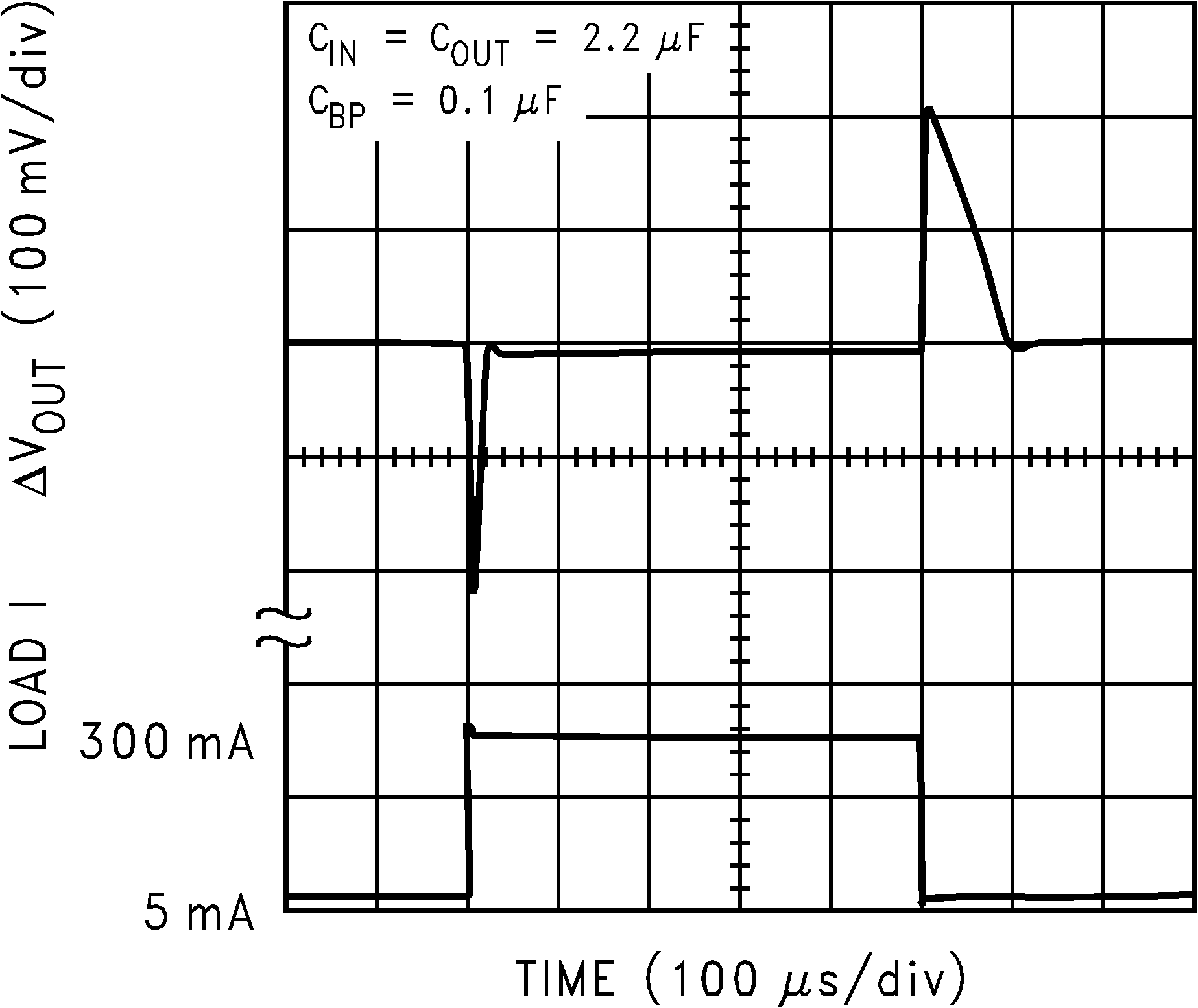
| VIN = 3.5 V |
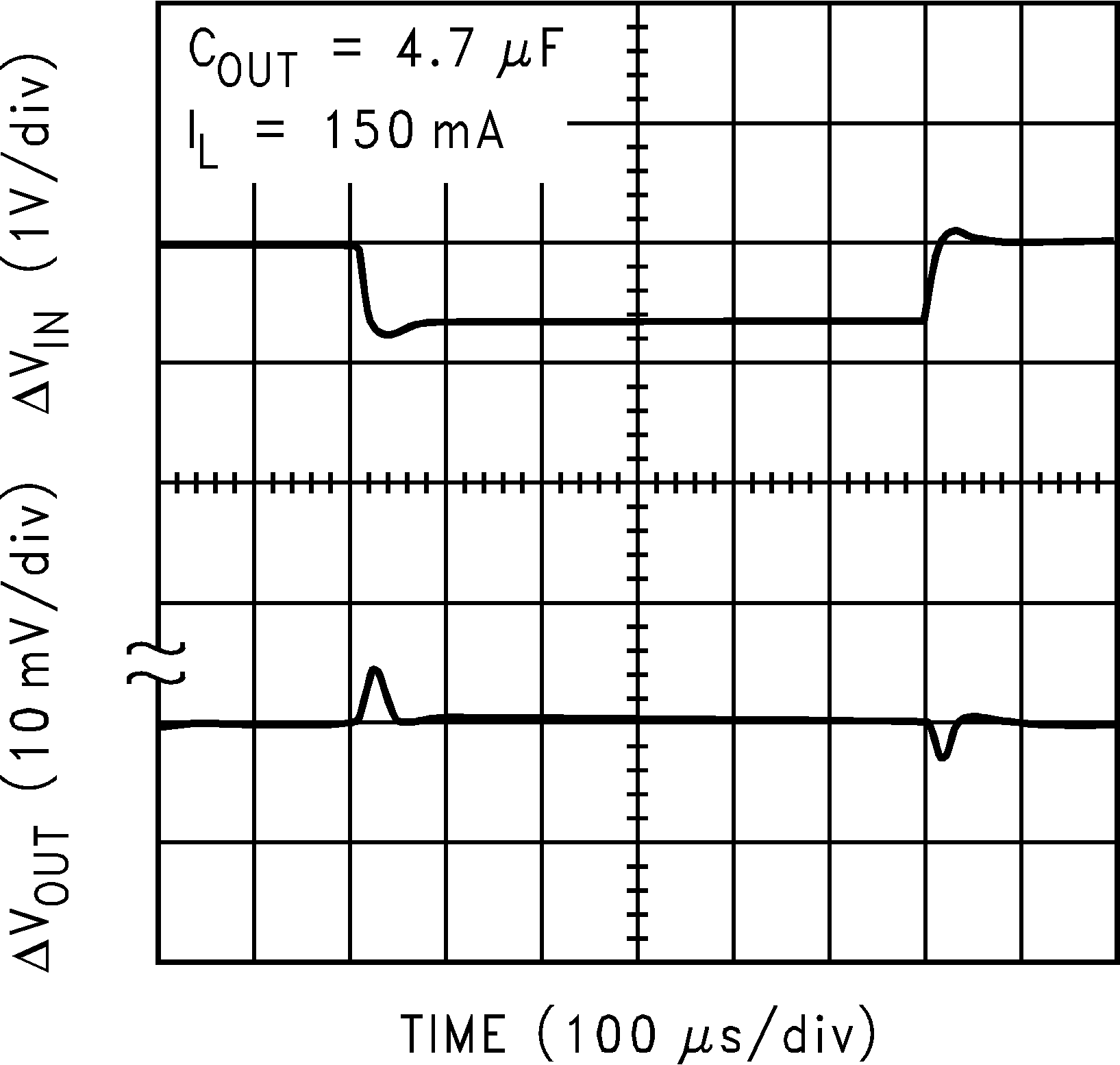
| VIN = VOUT + 1 V To VOUT + 1.6 V |
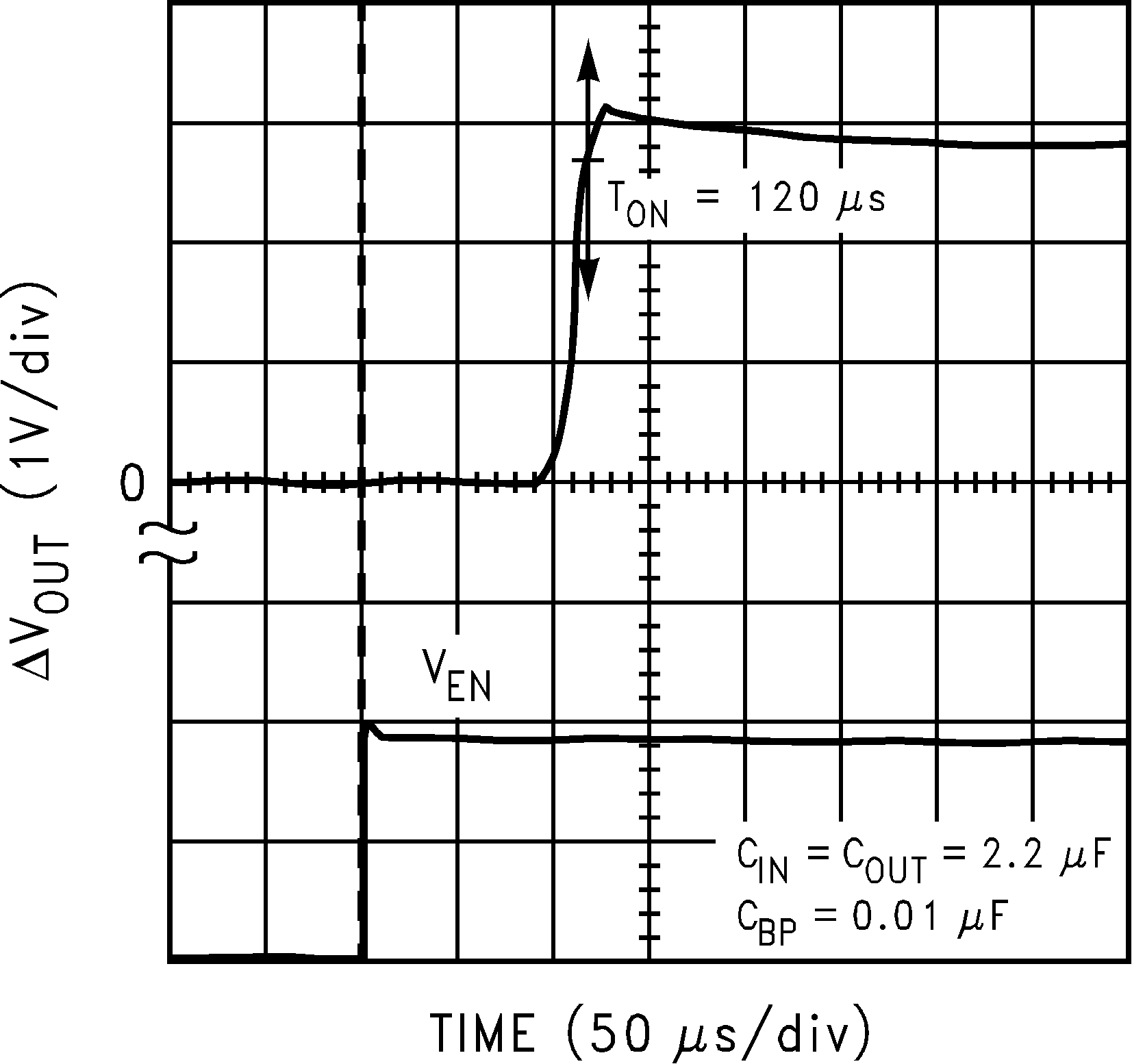
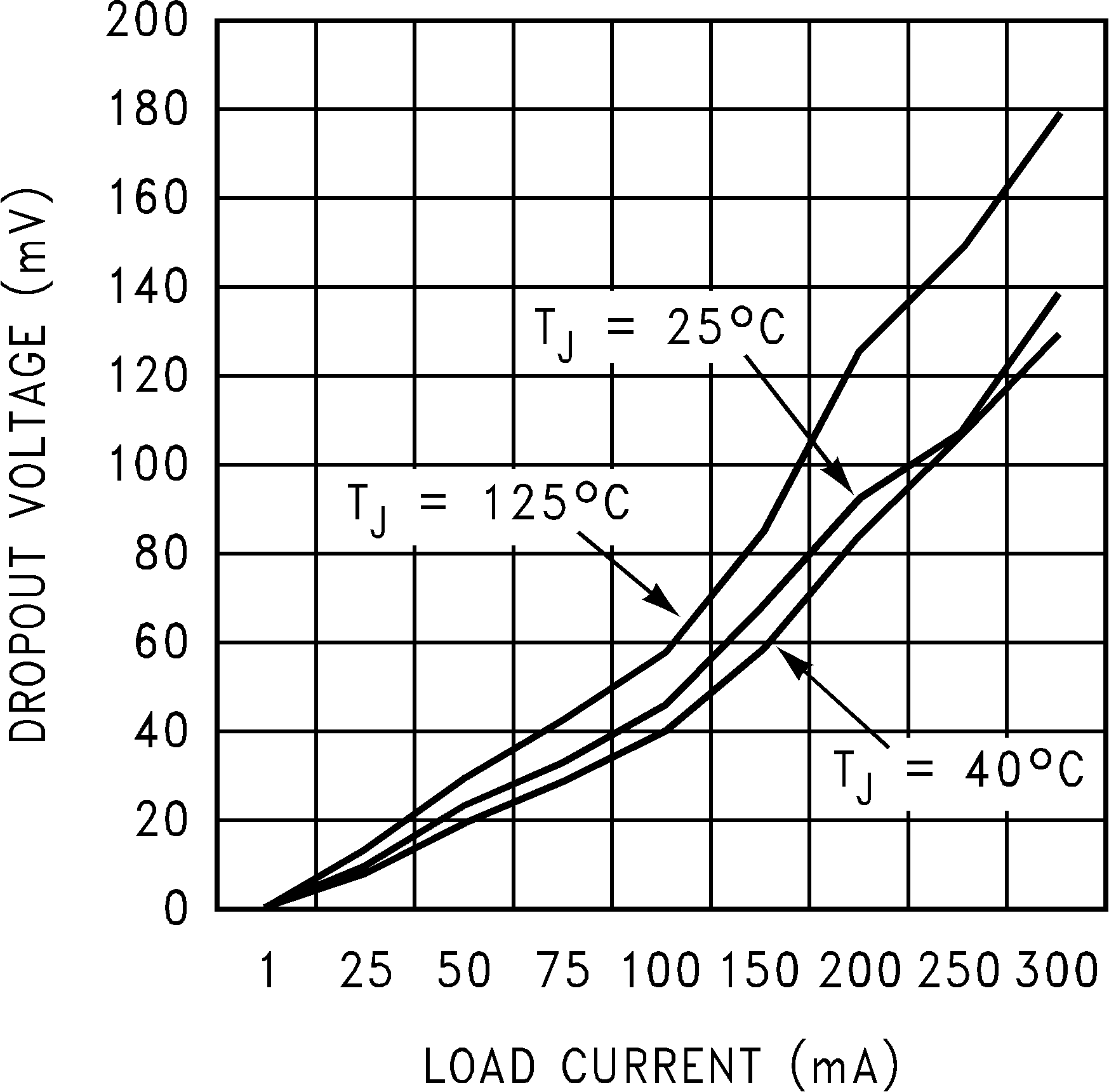
| VOUT = 2.85 V | ||
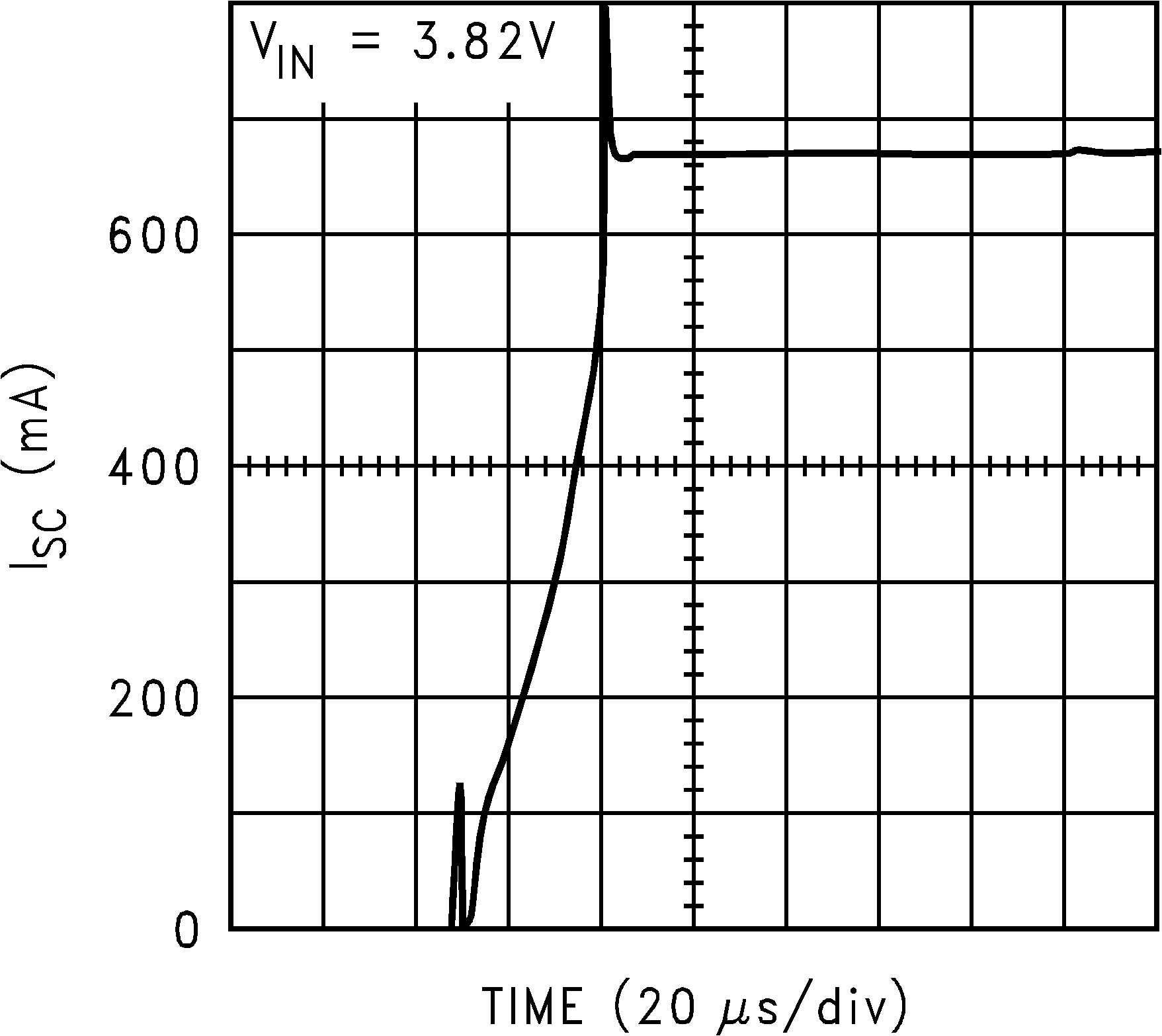
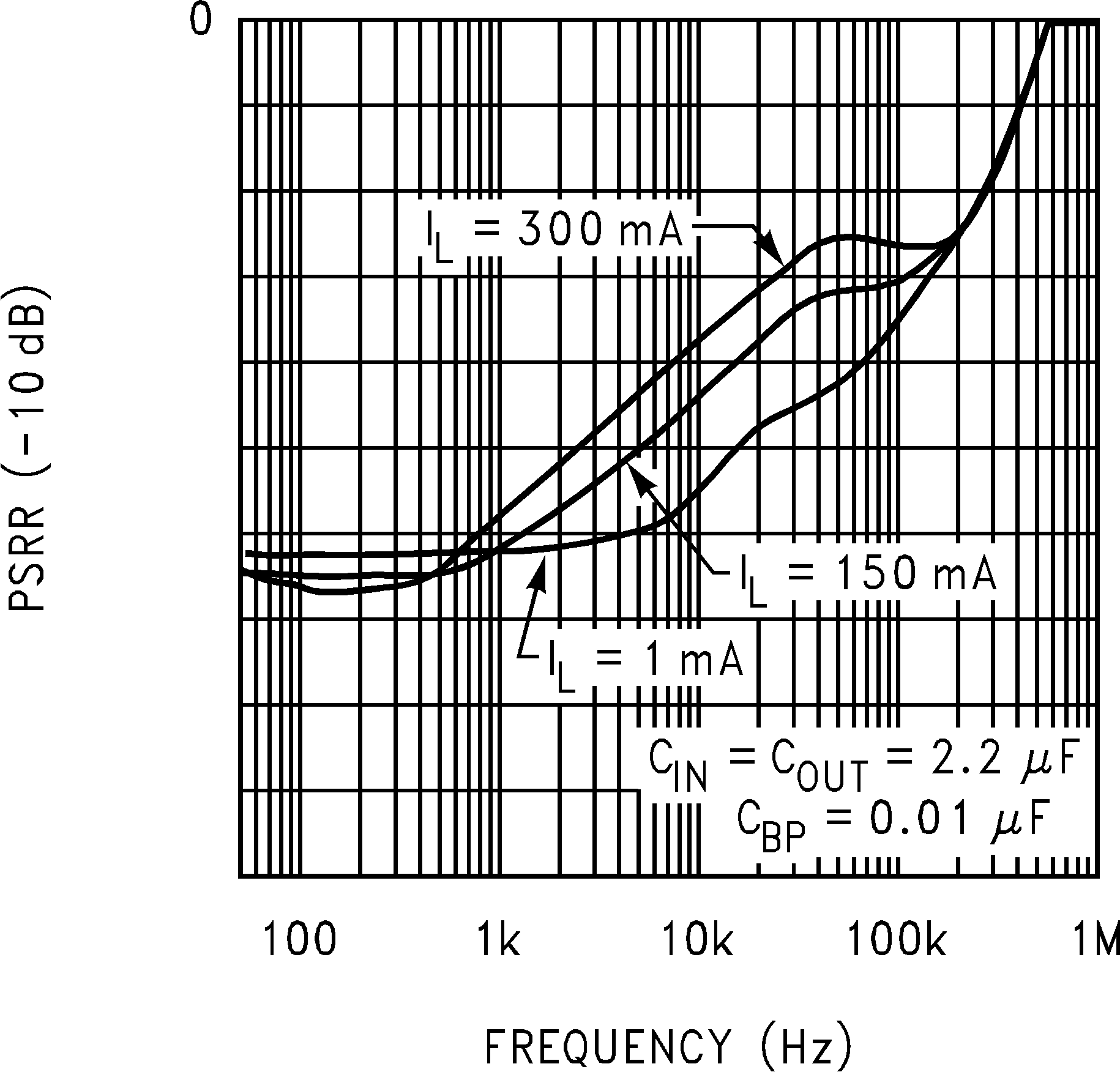
| VIN = VOUT + 1 V |
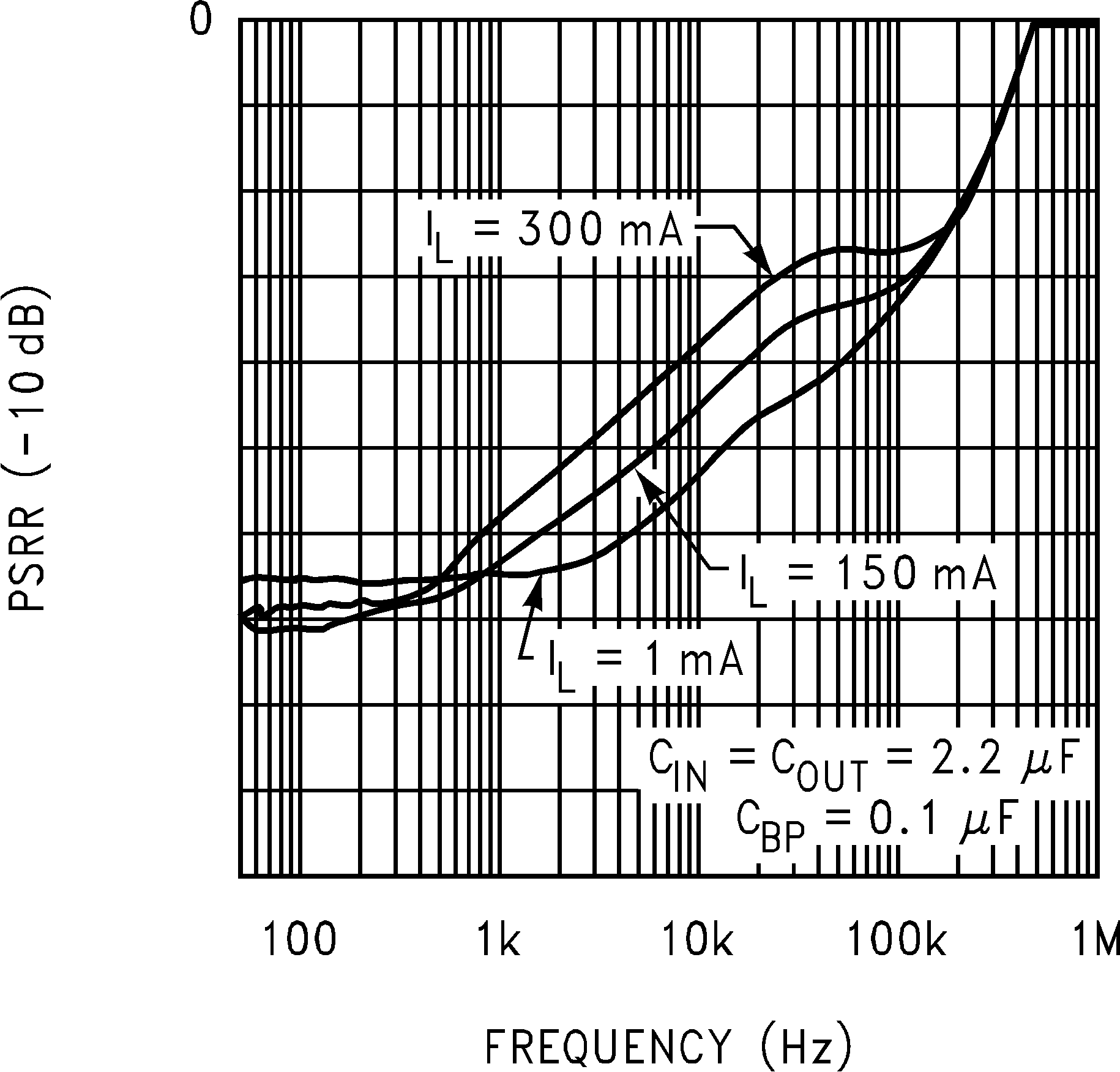
| VIN = VOUT + 1 V |
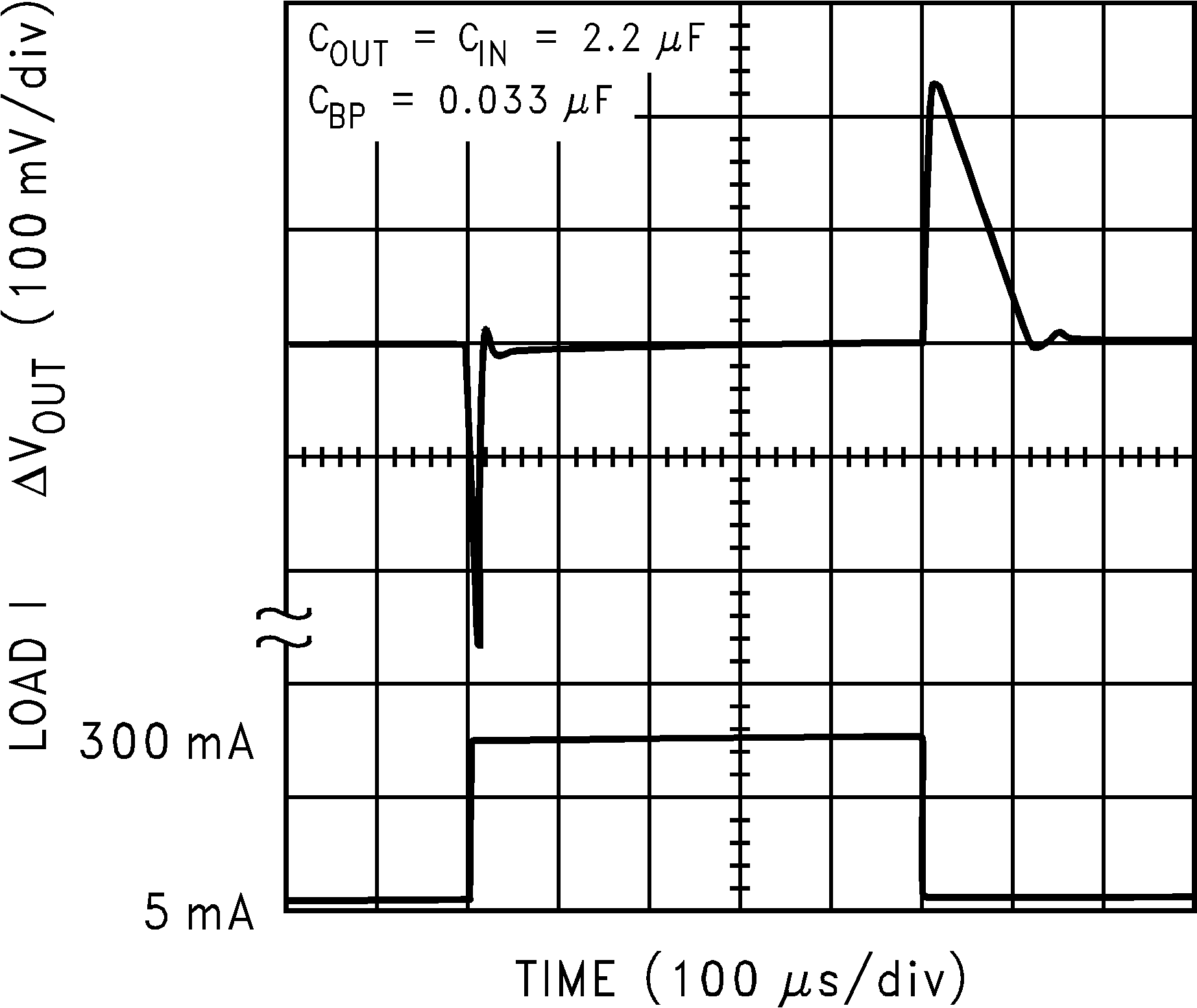
| VIN = 3.5 V |
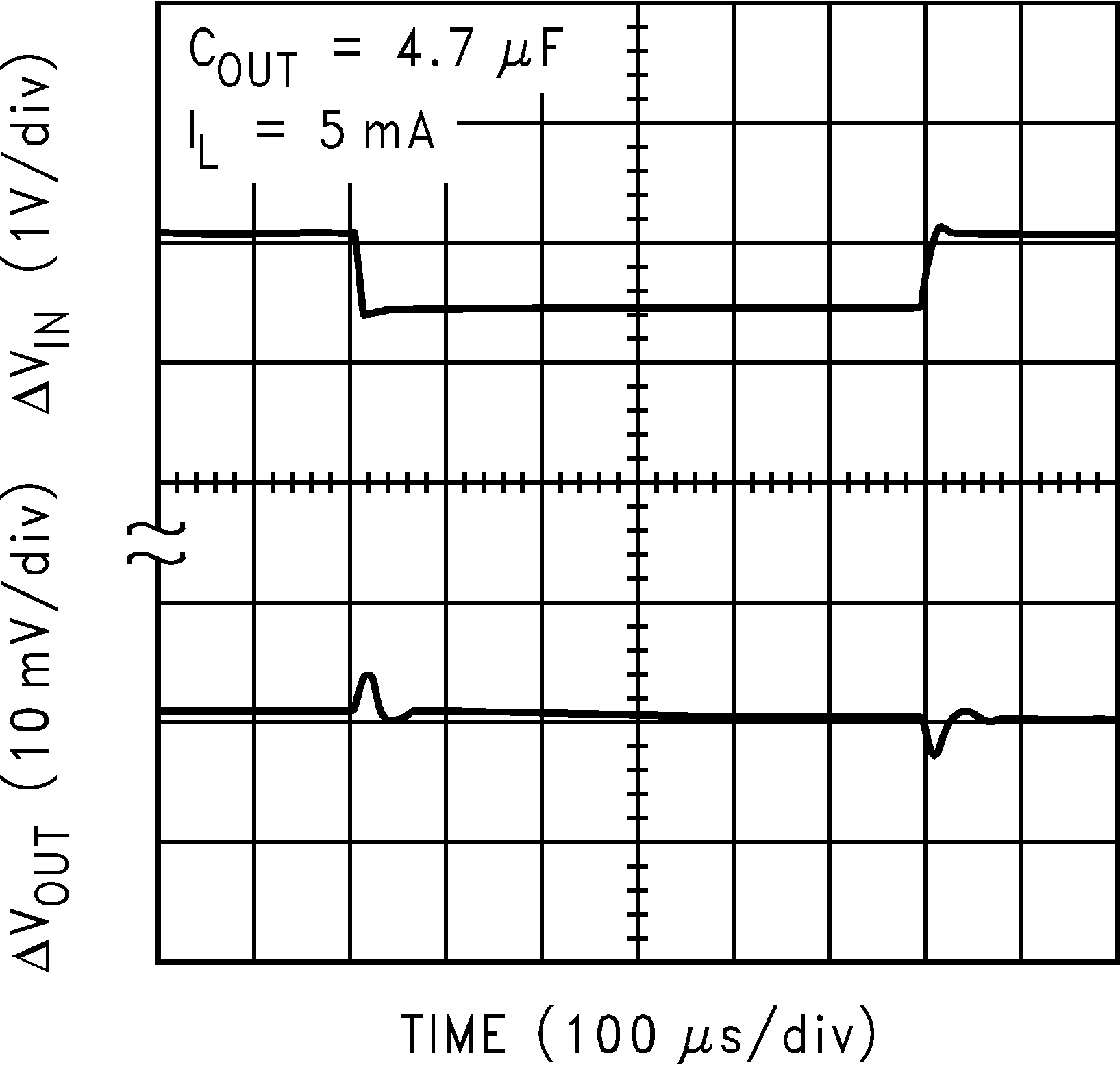
| VIN = VOUT + 1 V to VOUT + 1.6 V |
